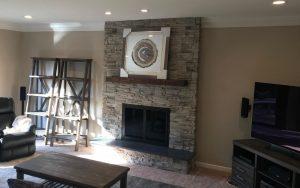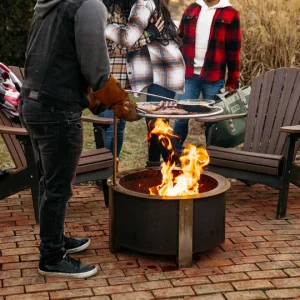A Step-by-Step Guide to Lighting Your Gas Fireplace
Lighting a gas fireplace can be intimidating, especially if you’ve never done it before. This step-by-step guide will walk you through the entire process from start to finish, ensuring that your gas fireplace is lit safely and efficiently.

How to light your gas fireplace
If you have a gas fireplace, you know how convenient and easy they are to use. But what do you need to light a gas fireplace? Reaching out to a qualified fireplace expert is always your best option, but if you plan to do it yourself, here is a step-by-step guide to lighting your gas fireplace. Before proceeding with ignition, ensure all safety measures mentioned below have been reviewed and followed. Gas fireplaces utilize three primary ignition methods, each requiring specific steps for safe operation. Identify your fireplace model and adhere to the appropriate lighting procedure to prevent hazards and ensure proper functionality.
**Method 1: Control Panel with Pilot Light**
This system includes a standing pilot light (a small flame that stays lit) and a manual control knob.
Steps:
Locate the control panel, typically behind the bottom louver or a drop-down panel.
Turn the knob to “OFF” and wait at least 5 minutes to clear any residual gas.
Turn the knob to “PILOT” and push it in slightly.
Press the igniter button repeatedly while holding the knob in until the pilot flame appears.
Hold the knob in for 30 seconds to allow the thermocouple to heat up and sustain the flame.
Turn the knob to “ON” to light the main burner.
Adjust the flame height using the knob or remote, if applicable.
**Method 2: Fireplace Key with Manual Gas Valve**
Some older models have a key-operated gas valve near the floor or wall.
Steps:
Insert the fireplace key into the valve.
Prepare to light with a long lighter or extra-long match.
Hold the flame near the burner and slowly turn the key—the gas should ignite.
Adjust the flame height using the key.
Remove the key to prevent accidental gas flow when the fireplace is off.
**Method 3: Electronic Ignition with Wall Switch or Remote**
Modern systems often use intermittent pilot ignition (IPI), meaning the pilot ignites only when needed.
Steps:
Locate the control system (wall switch, thermostat, or remote).
Turn it on by flipping the switch or pressing “ON.” The system should automatically spark and light the fireplace.
Adjust the flame height, if applicable.
>>> Note: Some electronic ignition models may not operate during power outages unless they include a battery backup. Check your owner’s manual for details.

Safety Tips for Lighting a Gas Fireplace
When lighting a gas fireplace, always use extreme caution. Make sure that the area around the fireplace is clear of any flammable materials before proceeding. In addition, never leave the gas fireplace unattended while it is lit. Here are some other safety tips to keep in mind:
1. Read Your Owner’s Manual
Every fireplace model is different. Your owner’s manual provides specific lighting instructions and safety guidelines tailored to your unit. It’s your most reliable source for proper operation.
2. Check for Gas Leaks
Stand near your fireplace and check for any unusual odors. If you smell gas:
Do not attempt to light the fireplace.
Evacuate immediately and avoid turning on electrical switches.
Leave doors and windows open if possible.
Call your gas company or emergency services from a safe location.
Even a faint gas odor should be taken seriously, as leaks can be hazardous.
3. Understand Your Venting System
Proper ventilation is essential for safety.
Vented fireplaces require the chimney damper or vent to be fully open before lighting. This prevents carbon monoxide buildup.
Vent-free fireplaces (also called ventless) do not use a chimney, but they require adequate room airflow. Follow the manufacturer’s guidelines and ensure your space meets ventilation requirements.
4. Install and Maintain Carbon Monoxide Detectors
Every home with gas appliances should have functioning carbon monoxide (CO) detectors on every level, especially near bedrooms.
Test them monthly and replace them according to manufacturer guidelines (usually every 5–7 years).
Place detectors at least 15 feet away from the fireplace to reduce false alarms.
Never rely solely on your fireplace’s built-in safety features—always have CO detectors as an additional safeguard.
5. Maintain Safe Clearances
Keep flammable materials—such as curtains, furniture, books, and decorations—away from the fireplace opening. Always follow the clearance guidelines in your owner’s manual to prevent fire hazards.
6. Use a Safety Barrier
Modern gas fireplaces include a protective barrier screen or safety glass to prevent accidental contact. Fireplace glass can reach over 400°F within minutes, posing a serious burn risk. If your unit doesn’t include a screen, consider adding one, especially if children or pets are present.
Troubleshooting Common Problems with Lighting
If your gas fireplace isn’t lighting, there are a few things you can check before calling a professional. Make sure the pilot light is on—if it’s not, follow the manufacturer’s instructions for relighting it. If the pilot light is on but the fireplace still won’t light, check to see if the gas valve is turned to the “on” position. If it is, try opening and closing the valve slightly to see if that gets the gas flowing.
If your fireplace lights but then goes out shortly after, there are a few possible causes. One is that the flue isn’t open—so be sure to open it before lighting the fire. Another possibility is that there’s something blocking the airflow into the fireplace. So take a look and see if there’s anything blocking the grates or vents. If not, then it could be that the damper isn’t fully open— so give it a good push to make sure it’s all the way open.
If your fire burns for awhile and then starts to smoke, that usually means there’s not enough air flow. So again, check to see if there’s anything blocking the vents or grates. If not, then you may need to adjust the damper to get more air flowing into the fireplace.
Here are a few common reasons your fireplace won’t light:
Pilot light keeps going out – A faulty thermocouple or thermopile may need professional replacement.
No gas flow – Ensure the shut-off valve is open and your home’s gas service is active.
Electronic ignition fails – Replace the remote or receiver batteries, and inspect the ignition system for dust or debris.
Never attempt to force ignition or bypass safety features! If you’re unsure, call a licensed fireplace technician.
Schedule Regular Maintenance
Lighting your fireplace is only part of safe operation. Schedule a professional inspection and cleaning at least once a year to:
• Check for gas leaks
• Clean the burner and logs
• Ensure proper ignition and airflow
• Test all safety components
At Heat & Sweep, our expert team helps homeowners in Southeast Michigan, keep their fireplaces running safely and efficiently year after year.

Stay Warm and Worry-Free
A gas fireplace adds warmth, charm, and efficiency to your home. With proper care and attention to safety, you can enjoy peace of mind alongside your beautiful flame.
Need help lighting your gas fireplace, scheduling maintenance, or choosing a new model? Contact a Heat and Sweep fireplace expert or visit us at the Golden Gate Shopping Center in Canton, Michigan – we’re always here to help you stay cozy and safe!



